Extra fluffy Korean twisted donuts (kkwabaegi) with a crispy golden exterior. Rolled in cinnamon sugar and topped with fresh cream. This recipe is authentic and can be made with or without a stand-mixer.

I don’t think I’ve ever met a donut I didn’t like. They’re decadent and delicious and they keep you reaching for a second serving. These Korean twisted donuts, known as ‘kkwabaegi’, are at the top of my list!
It’s no surprise that Korean donuts are one of the most popular Korean street foods. They are soft and fluffy interior and a perfectly crispy exterior, topped with cinnamon sugar or various toppings.
Korean bakeries and cafés love taking traditional desserts and making them extra by adding various toppings and icings. These twisted donuts are no different, as the topping options are endless! So whether you want a sweet or savoury donut, kkwabaegi is the one for you!
Along with Hotteok, Gilgeori Toast and Korean Cream Cheese Garlic Bread, twisted donuts can be found in all street food markets. Korean bakeries usually serve kkwabaegi alongside Korean Strawberry Milk or Korean Lunchbox Cake.
Without further ado, let’s flour our hands and get started!
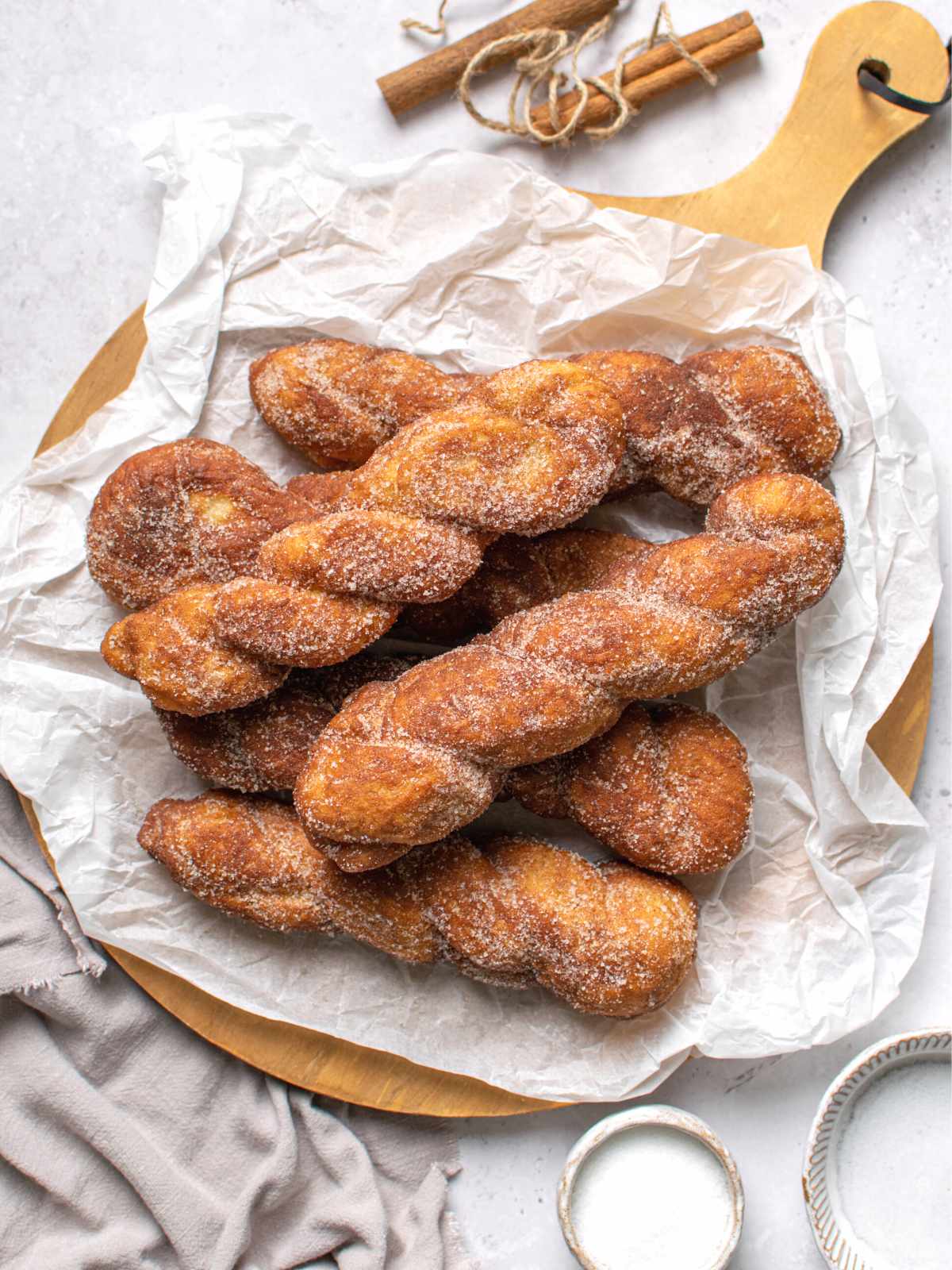
What is Kkwabaegi?
Kkwabaegi (꽈배기) or Korean Twisted Doughnut is a deep-fried sweet yeasted donut twisted in the shape of a spiral. They are typically rolled through cinnamon sugar and served fresh, whilst still hot.
The name Kkwabaegi (in Hangul 꽈배기) comes from the verb 꼬다 (kkota), which means “to twist”. Translated literally, kkwabaegi means “twisted bread stick”.
Korean twisted donuts are an incredibly popular street food. They can be found in all food markets around South Korea, as well as in local bakeries and cafés. Kkwabaegi has been around for centuries, but it’s been making a massive comeback in the last decade. Nowadays it’s considered a ‘retro’ dessert in South Korea, with many bakeries trying to reinvent it with new toppings and flavours.
Served fresh, kkwabaegi is extremely soft and fluffy, practically melting in your mouth. The secret to perfect twisted donuts is the sweet dough, which requires a lot of careful kneading and shaping.
Kkwabaegi tastes best immediately after it's made, although chances are there won't be any left later anyway! Traditionally served plain with only cinnamon sugar, nowadays bakeries in Seoul are making them extra special by adding fun toppings.
Korean treats are typically a combination of sweet and savoury, so the plain sugar Korean donuts can be used with any flavour combination. Cheese spread, crackers, fruit, cereals, vanilla cream, garlic or chocolate are only a few of the new popular flavour offered by kkwabaegi street vendors.
Twisted donuts are so famous that a popular Korean drama was named after it. Titled 사랑의 꽈배기 (Love Twist), this 2021 drama has just as many twists as a kkwabaegi.
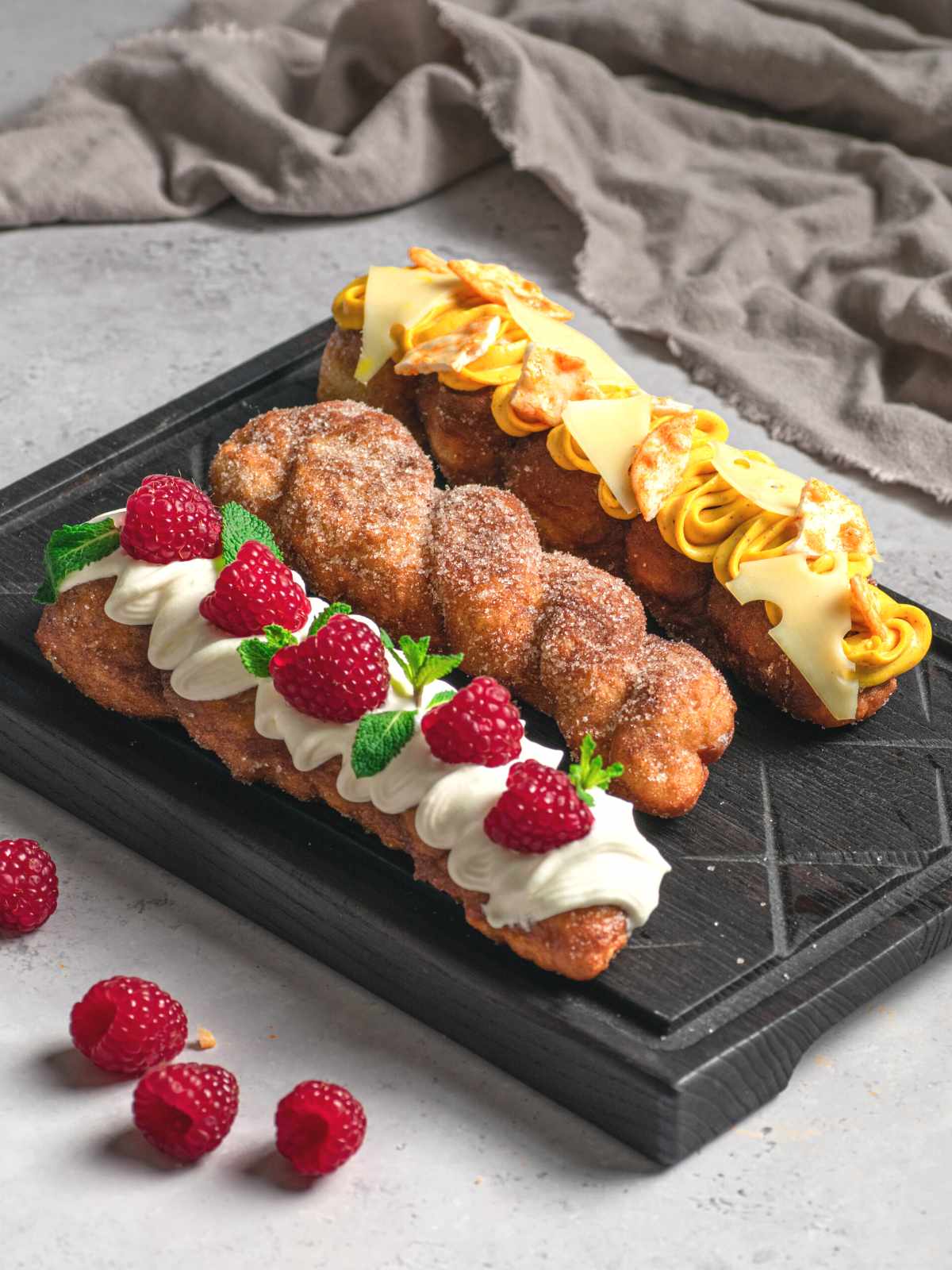
Origin
Historically, Kkwabaegi is believed to originate from Hui people of the Hangzhou region in China. Originally known as “mahua” (麻花), they are believed to go back thousands of years.
Twisted donuts made their way to the Korean peninsula towards the end of the Joseon Dynasty (19th century). It is thoughts that Chinese immigrants brought it over in the 19th century. Initially accessible only to the wealthy due to the high cost of wheat flour, kkwabaegi became more popular after the Korean War in the 1950s.
Once flour became readily available in South Korea, kkwabaegi turned into an incredibly popular snack due to its cheap cost.
Twisted donuts are popular all over the world and they are knows as:
- China: Mahua or Mahwa (麻花)
- Japan: Sakubei (索餅/さくべい)
- Philippines: Shakoy or Siyakoy or Lubid-lubid
- Vietnam: Bánh Quẩy Thừng
- Italy: Treccia
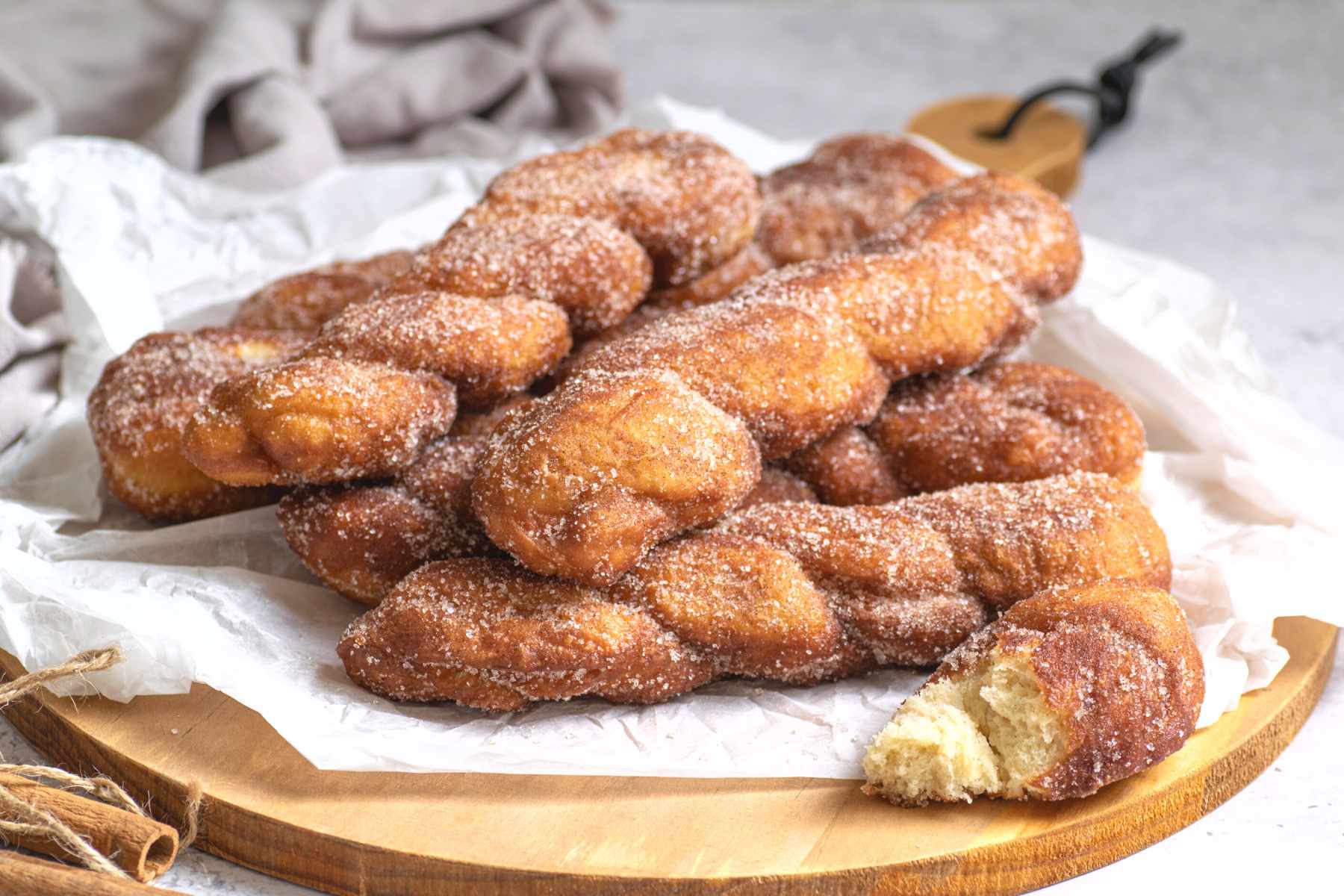
What does it taste like?
Plain Kkwabaegi taste sweet and fragrant. They taste just like a plain deep-fried donut, just much softer and fluffier. The double proofing makes them extra soft on the inside, whilst the deep frying gives them a perfect crisp exterior.
The flavour comes from the cinnamon sugar it’s rolled through, which makes it sweet, with a spiced kick. Being deep-fried, the donut also has a lovely fried flavour, which pairs so well with the sweetness.
Twister donuts are delicious plain or with extra toppings. They are very versatile and can be topped with fresh cream, fruit, cheese or chocolate. The options are endless!

Korean Twisted Donuts vs Regular Donut
Although they can taste similar to regular donuts, Korean twisted donuts are different. They are much softer, can sometimes be a little chewy and are shaped differently. The main differences are:
- Shape: Kkwabaegi is shaped by twisting a thin strip of dough to form a long spiral. Regular donuts are typically cut out using a donut or cookie cutter to look round, sometimes with a hole in the middle.
- Filling: Due to its twisted shape, Korean donuts are more difficult to fill, so toppings are only added on top. Regular donuts are usually filled with a variety of flavours.
- Texture: The texture is very similar, although Korean donuts are typically softer. Due to multiple proofing, Kkwabaegi comes out so soft that it melts in your mouth. Both types of donuts have a crispy exterior.
- Flavour: Traditional Korean donuts are only coated in a mixture of cinnamon and sugar. Regular donuts are usually glazed with icing or covered in chocolate.
Ingredient round-up
This Kkwabaegi recipe is great because it uses very plain ingredients that can be found in most pantries. Here’s what’s needed:
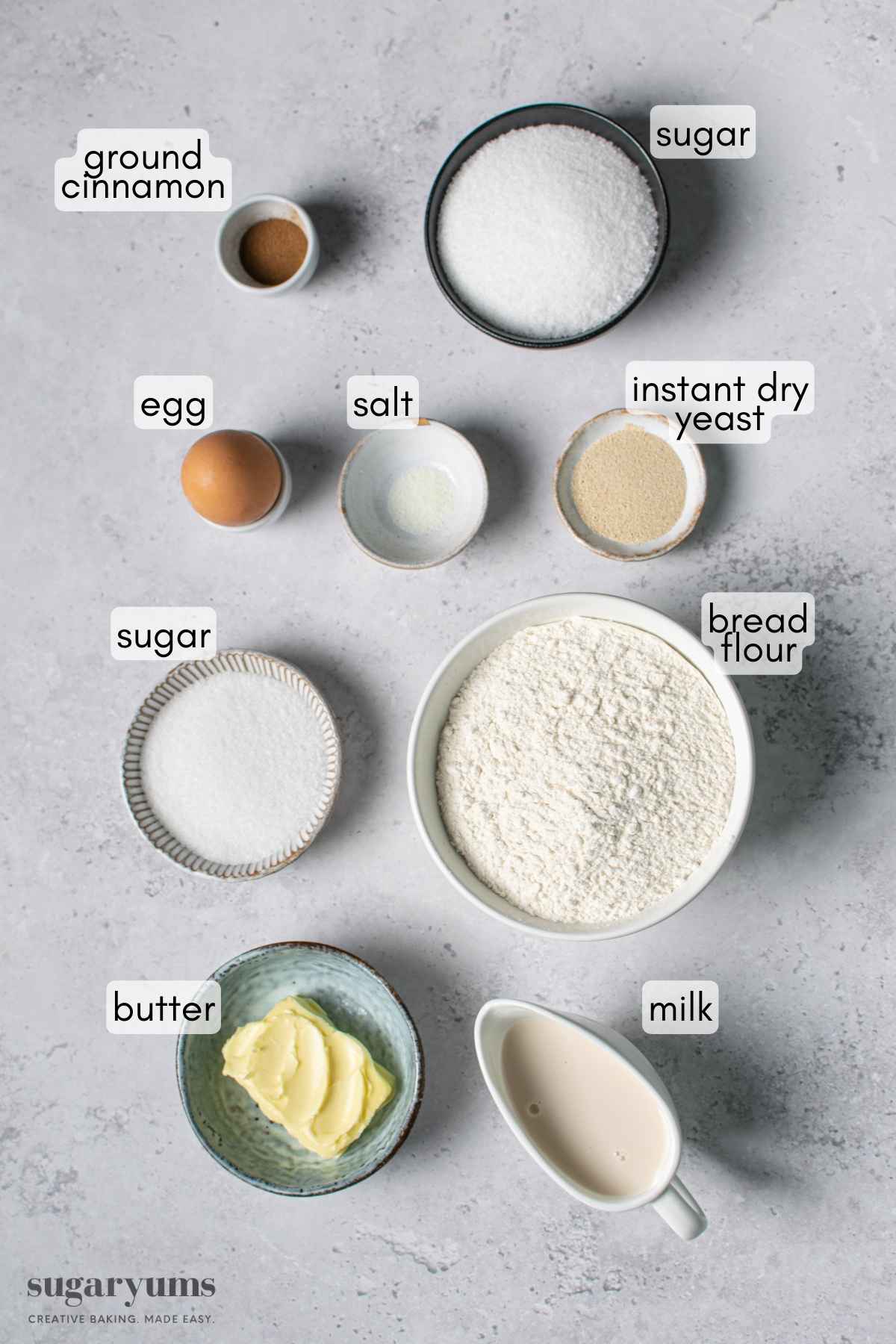
For the dough:
- Milk – you can use any type of milk, including plant-based. You can also substitute milk with water. Personally, I recommend using full-fat milk for the best flavour. Ensure the milk is lukewarm (but not hot) when using.
- Yeast – Instant dry yeast works best because it’s easiest to use. However, you can also use fresh yeast for an even fluffier donut.
- Sugar – Regular granulated sugar
- Egg – Large eggs work best. Leave eggs at room temperature before using.
- Salt – Use fine salt for this recipe.
- Flour – I recommend using bread flour for this recipe, as the high gluten in the flour yields the best results. You can also use all purpose flour, but I strongly recommend getting bread flour if possible. For a slightly chewier texture, you can use some tapioca flour (3 parts bread flour and 1 part tapioca flour).
- Butter – Plain unsalted butter works best. I do not recommend replacing butter with oil. However, you can use margarine if needed.
For the topping:
- Sugar – Plain granulated sugar works best for coating the donuts.
- Cinnamon – Use fine ground cinnamon. You can also use other spices like nutmeg, ginger or allspice for a stronger kick.
How to make Kkwabaegi

1. Combine the yeast and lukewarm milk. In a large bowl, mix all the ingredients for the dough, except for the butter.

2. Knead until a dough forms. Add pliable butter into dough, then knead until soft and smooth. Cover and let proof for 1 hour.

3. Divide dough into 10 pieces. Roll dough pieces into long strips.

4. Twist each side of a dough strip towards opposite sides.

5. Pinch the twisted strip ends, lift into the air and let strip twist itself into a spiral. Cover and proof again until fluffy.

6. Deep fry in hot oil until golden-brown in colour.

7. Place on wire rack for 5 minutes to drain excess oil. In a small bowl, combine sugar and cinnamon. Roll hot donuts through cinnamon sugar.

8. Optional: Add any desired toppings and decorate.

Flavour Variations
Nowadays, Korean Twisted Doughnuts come in all flavours. They can be sweet, savoury or both! Make the Kkwabaegi as indicated, then let them cool down and decorate with your favourite toppings.
Here are some of my favourite flavours:
- Berries and cream – top with whipped cream and decorate with fresh berries such as strawberry, raspberry or blueberry.
- Cheese – add a savoury kick with cheesy toppings! I like to use cheese spreads or cream cheese, then top with savoury crackers and pieces of cheese. Gouda, Emmental, Parmesan or American cheese all work wonders!
- Cereals – Top with fresh cream or sugar icing, then sprinkle crushed cereals or candy on top.
- Chocolate – Melt some of your favourite chocolate, then dip the donuts into it. Let set, then enjoy!

Success Tips & Tricks
- Good yeast: yeast can make or break most donut recipes. Make sure you test if youe yeast is alive before commencing the recipe. Mix a little yeast in a tablespoon of lukewarm water or milk, then let it sit for 5-10 minutes. If it bubbles up and becomes foamy, the yeast is active. If nothing happens, the yeast has gone bad and you need to buy a new pack.
- Lukewarm milk: Yeast needs warmth to rise, so ensure the milk is lukewarm. It should feel the same temperature as your body. If it’s too hot, it can kill the yeast and you won’t get a good rise.
- Pliable butter: Leave your butter at room temperature for at least 1-2 hours before using it. Cold butter will make it difficult to knead it into the dough.
- Knead well: Ensure you knead the dough very well. You can use either a stand mixer with dough hook attachment or knead by hand. In both cases, the dough needs to pass the ‘windowpane method’.
- Double proofing: The dough needs plenty of growing time to yield extra soft and fluffy Kkwabaegi. It’s important to proof the dough after kneading for 1 hour. The second proofing is after shaping the donuts, for an additional 30 minutes to 1 hour.
- Oil: Use a flavourless and odourless vegetable oil, like sunflower or canola oil (rapeseed oil). Oils with a strong taste can alter the flavour of the Korean twisted donuts.
- Frying temperature: It’s best to use a kitchen thermometer if possible. The oil temperature needs to read 300-325F (150-165C). If the temperature is less than this, the donuts will soak up too much oil and come oil very greasy. If the oil is too hot, it can burn the donuts.
- Topping: Coat the donuts in sugar whilst they’re still hot and a little oily. This way the cinnamon sugar will stick to it much better.
- Serve hot: Kkwabaegi tastes best immediately after making, so I recommend serving them whilst still warm.
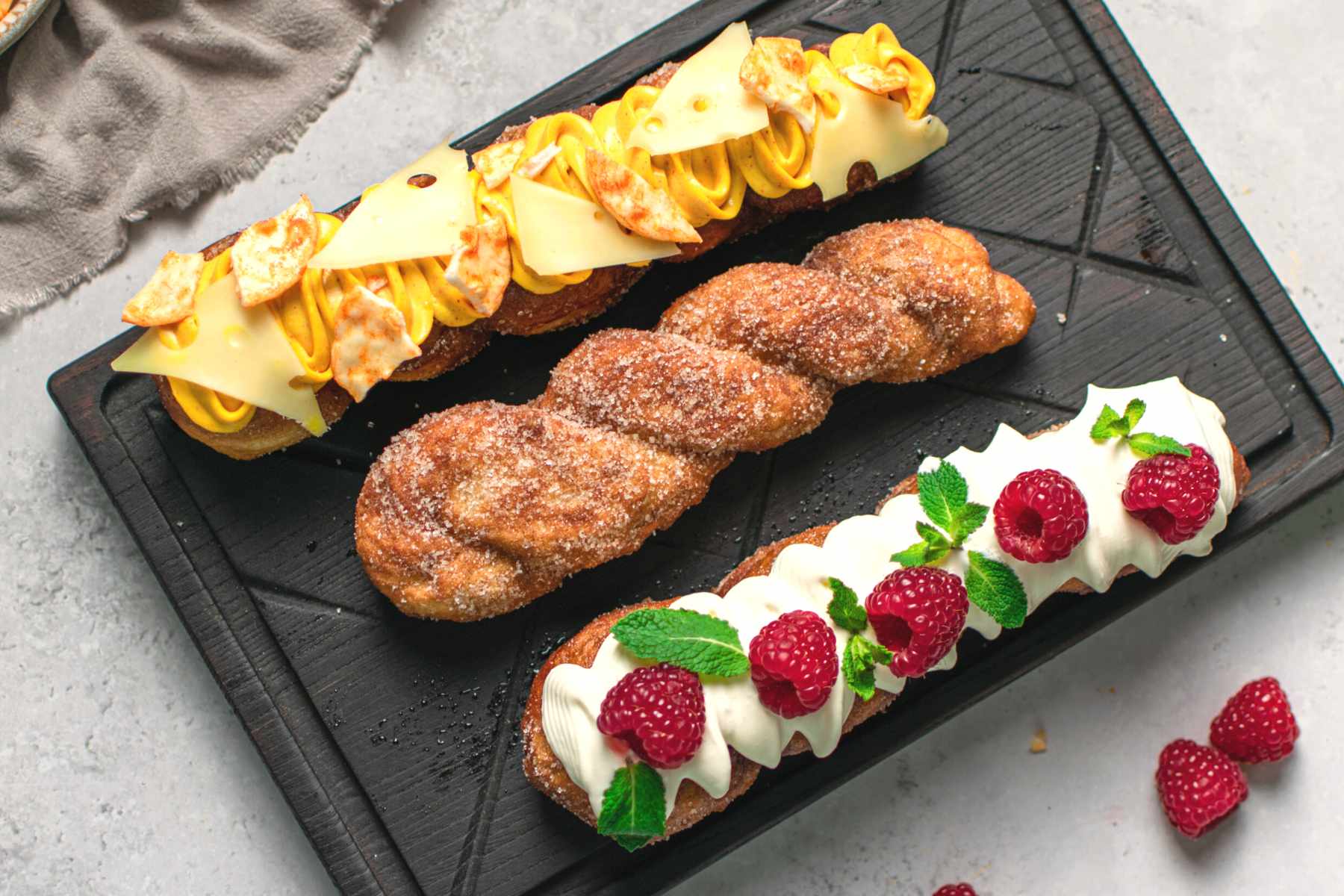
Serving & Storing
Serving: I recommend serving Korean twisted donuts freshly made, whilst still warm. This way they will be perfectly soft inside, with a crispy exterior.
Storing at room temperature: Kkwabaegi will last for up to 2-3 days at room temperature (with sugar cinnamon coating ONLY). I recommend adding any toppings immediately before serving.
Refrigerating: I do not recommend refrigerating Korean doughnuts, as it can make them too tough and stale.
Freezing: Korean twisted donuts freeze well, only with cinnamon sugar coating. I do not recommend freezing them with any other toppings. Freeze for up to 2-3 months in an airtight container or ziplock bag.
Reheating: Reheat from room temperature by placing in a hot oven for 2-3 minutes. Reheat from frozen in a hot oven for 5-6 minutes or until hot. You can also use an air fryer, but it may take less time.

If you enjoyed this recipe, you will love these too:
If you’ve tried this recipe out, please don’t forget to rate and comment on this post. I love hearing from you, so feel free to reach out to me on social media as well and tag me in your posts!
Recipe

Korean Twisted Donuts Recipe: Kkwabaegi (꽈배기)
Ingredients
For the dough
- ½ cup milk, lukewarm * (115 grams)
- 1 packet instant dry yeast * (7 grams)
- ¼ cup plain sugar (50 grams)
- 1 large egg, room temperature
- ¼ teaspoon fine salt
- 2 ¼ cups bread flour (300 grams)
- ¼ cup butter, room temperature (50 grams)
Extra
- vegetable oil, for frying *
Topping 1: Cinnamon Sugar
- ½ cup plain sugar (100 grams)
- 1 teaspoon ground cinnamon
Topping 2: Berries & Cream
- 1 cup heavy cream (100 grams)
- 2 tablespoons powdered sugar (20 grams)
- ½ teaspoon vanilla extract or vanilla bean paste
- 1 cup fresh berries
- mint leaves, optional
Topping 3: Cheese & Crackers
- 1 cup cheese spread
- 10-12 salted crackers, small pieces
- 2-3 slices cheese (Emmental or Gryuere)
Instructions
- In a large mixing bowl, pour the lukewarm milk, yeast and sugar. Mix well to combine, then let sit at room temperature until bubbles or foam form on the surface.
- Add in the egg and mix well. Sift the flour and salt into the wet ingredients.
- Use a wooden spoon or spatula to combine into a loose dough. Knead gently in the bowl, until the dough is in one single piece.
- Cover the bowl with plastic wrap or a damp kitchen towel and let sit at room temperature for 15 minutes.
- If using stand mixer, knead with dough hook. For hand kneading, gently flour the work surface. Knead by gently pulling the dough away, stretching it, then roll it backwards and repeat for about 4-5 minutes.
- Add the room temperature butter into the dough, then start kneading it in. It will be a bit messy at first, but keep going until the dough fully absorbs the butter. Knead until the dough is smooth and no longer sticky, for 10-15 minutes.
- Once again cover the bowl with plastic wrap, then let the dough proof in a warm place for about 1 hour.
- When doubled in size, deflate a little air by pressing down on the dough. Divide the dough into 10 equal pieces, then shape them into round balls.
- Work with one piece at a time, covering the remaining with plastic wrap to prevent them from drying out. Press down onto one ball of dough to flatten it into a disc. Roll the disc into a log, pinching the ends to seal the dough. Use both palms to roll the log into a thin coil, about 40 cm long.
- With the palm, roll each end in opposite directions, until the coil looks visibly twisted. Grab each end and lift up the coil, which will twist into the shape of the twisted donut on its own. Pinch the edges well to seal in the twist.
- Repeat the process with the remaining dough balls, covering the twisted donuts with plastic wrap. Once all are completed, leave them fully covered in a warm place. Prove for 30 minutes to 1 hour until they look fluffy.
- In a deep skillet, heat up plenty of vegetable oil until the temperature reaches 300-325°F (150-165°C). Drop in two donuts at a time, frying them for about 2-3 minutes on each side or until golden-brown in colour. Constantly check the oil temperature to maintain it constant.
- Place the cooked donuts on a wire rack or plate lined with paper towels to soak off excess oil.
- Whilst still hot, roll each donut through a sugar and cinnamon mixture.
Topping 2: Berries & Cream
- Whip heavy cream, vanilla extract and sugar until stiff peaks. Place cream into a piping bag fitted with decorative nozzle.
- Pipe cream onto completely cooled donuts. Top with fresh berries and mint leaves.
Topping 3: Cheese & Crackers
- Place cheese spread into a piping bag fitted with decorative nozzle. Pipe cheese on top of completely cooled donuts.
- Top with pieces of salty or cheese crackers and small pieces of cheese.
- Optional, use a blowtorch to gently melt the cheese on top.
Notes
- I recommend using a kitchen scale in grams for more accuracy. The cups used for the conversion are standard US customary cups (1 cup flour = 136g). There are many different types of cups across the globe, which is why I strongly recommend using grams instead.
- Nutritional value is estimative only and it's calculated per serving with plain cinnamon sugar topping (this recipe makes 10 twisted donuts).
- Any type of milk can be used, including plant-based alternatives.
- Test if yeast is live before commencing recipe. Please see post section Success Tips & Tricks for more details.
- Use an odourless, flavourless vegetable oil like sunflower or canola (rapeseed).
- Serve whilst still warm.
Nutrition
Pin this recipe for later!








Suzanna says
I've made Korean donuts before, but omgg these were so much more fun! Adding toppings is such a fun idea. I made it with cream and blueberries, ice cream and cookies and one with cream cheese and jam. They were all so yummy!